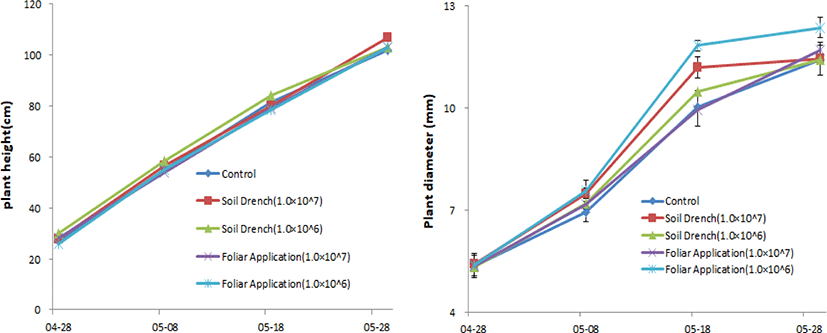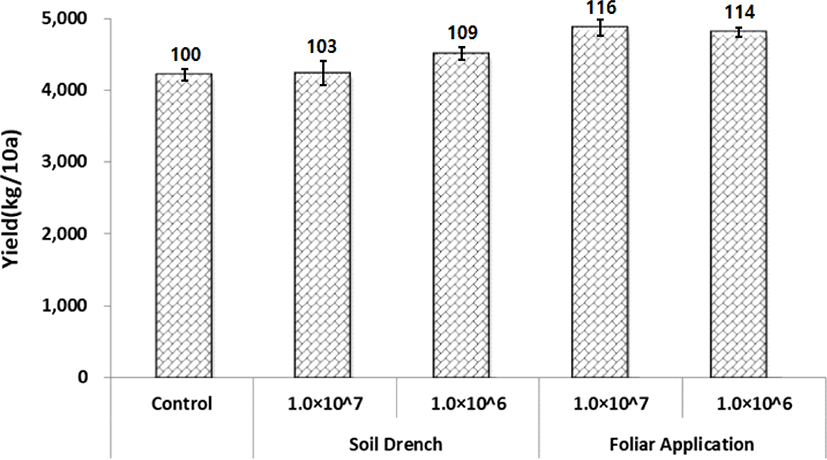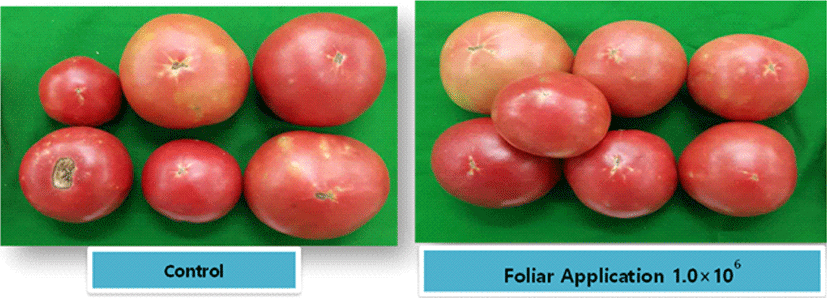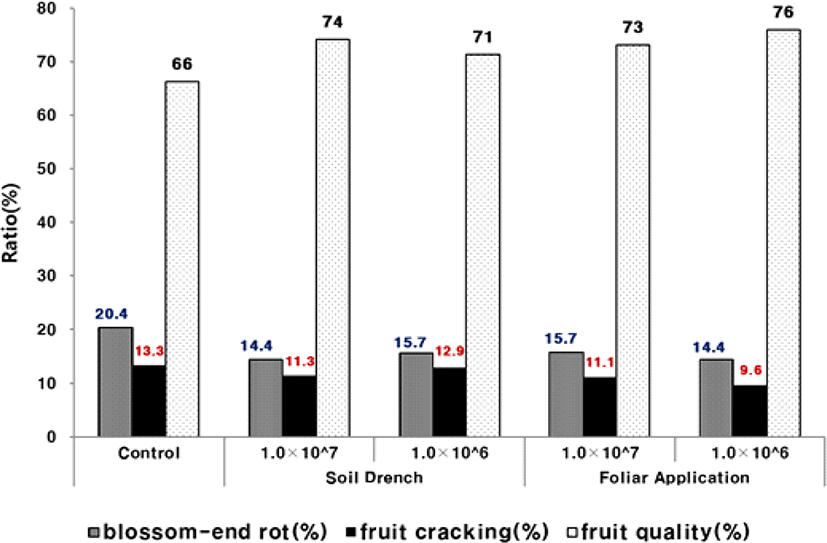Article
유용미생물처리가 토마토 수량 및 과실 성분에 미치는 영향
김은정1, 김충우1,*, 김선국1, 장후봉1, 김영호1, 송재경2, 권장식2
Effect of Effective Microorganism Applications on Growth, Yield and Fruit Nutrient Contents in Fresh Tomato
Eun-Jeong Kim1, Chung-Woo Kim1,*, Sun-Kook Kim1, Who-Bong Chang1, Young-Ho Kim1, Jae-Kyeong Song2, Jang-Sik Kwon2
Author Information & Copylight ▼
1Chungbuk Agricultural Research and Extension Services, Ochang 28130, Korea
2Agricultural Microbiology Division, National Institute of Agricultural Science, Wanju 55365, Korea
© Copyright 2018, Institute of Agricultural Science & Technology, Chonnam National University. This is an Open-Access article distributed under the terms of the
Creative Commons Attribution Non-Commercial License (http://creativecommons.org/licenses/by-nc/4.0/) which permits
unrestricted non-commercial use, distribution, and reproduction in any
medium, provided the original work is properly cited.
Published Online: Dec 31, 2018
ABSTRACT
This study was carried out to develop a method to effectively utilize Bacillus subtilis S37-2 strain, which has been proven to promote growth and antifungal effect on tomato cultivation. Soil treated with the suspension of Bacillus subtilis S37-2 showed a tendency that the electric conductivity (EC) decreased and the organic matter and effective phosphoric acid content increased more than the soil before the test. Bacillus subtilis S37-2 treated with the suspension was thicker and 3~16% larger than the control. In addition, navel rot was reduced by 4.7~6.0%, and heat loss was decreased by 0.4~3.7%, and the product overspeed ratio increased by 5~10%. The functional substances and antioxidative activities of the Bacillus subtilis S37-2 suspension were diluted to 1.0×106 CFU mL−1 concentration, and the sugar content of the leaves treated with leaf surface treatment was increased by 0.5 °Bx and the content of lycopene and vitamin C and DPPH radical scavenging ability, which showed antioxidant activity, was the highest. When the suspension of Bacillus subtilis S37-2 was applied to the tomato cultivation, it was diluted to 1.0×106 CFU mL−1 concentration, and after five rounds of foliar application every 7 days after the tomato planting, the growth was promoted and the quality was improved respectively.
Keywords: Bacillus subtilis S37-2; Tomato; Growth promotion; Effective microorganism
서 론
안전한 먹을거리에 대한 관심 증가와 지속가능한 농업을 위해 미생물을 활용한 친환경농업에 대한 연구와 투자가 이루어져 국내 미생물 시장도 급격하게 성장하고 있다. 다양한 유용미생물(Bacillus sp., Lactobacillus sp., Saccharomyces sp. 등)에 대한 농업적 효과가 검증되면서 시설재배지 중심으로 유용 미생물 수요가 증가하여 전국에 미생물을 보급하는 시 ․ 군 농업기술센터가 2016년 134개 지역으로 증가하였다 (RDA, 2016). 단일 미생물은 종류에 따라 작물생장 촉진, 병해충 방제, 토양개량, 품질향상 등 기능적 분류가 가능하지만, 현재 생산되어 보급되는 유용 미생물들은 대부분 세균, 젖산균, 효모를 혼합한 EM(Effective Microorganisms)으로 미생물 사용에 대한 효과를 명확하게 구분할 수 없다. 그리고 유용미생물의 작물에 따른 처리 효과 검증이 부족하여 제대로 된 미생물 처리 효과를 얻지 못하는 것이 문제되고 있다. 따라서 효과가 검증된 미생물에 대해 작물별 사용방법을 적립하여 농가에서 안정적으로 사용할 수 있는 사용법 개발이 필요한 상황이다. 본 연구는 내열성 및 내염성을 함께 가지고 있어 불량 토양환경에 대한 적응능력이 뛰어나며, 뿌리에 침투하는 식물병원균을 효과적으로 억제하고, 식물생육촉진 효과도 검증된 Bacillus subtilis S37-2 균주(Kwon et al., 2007)를 시설재배지에서 효과적으로 활용할 수 있는 처리 방법을 개발하고자 하였다. 대상작물은 2018년 기준 1인당 연가소비량이 7.1 kg, 2015년 기준 생산액이 9,850억 원으로 전체 농업생산액의 2.2%를 점유(KOSIS, 2018)하여 안정적 소비층이 확보되어 있는 토마토를 선정하였다.
재료 및 방법
1. 시험균주
본 연구에 사용된 Bacillus subtilis S37-2(KACC 91281P) 균주는 농업미생물은행(Korean Agricultural Culture Collection, KACC)에서 분양 받은 균주를 TSB(Tryptic Soy Broth, Difco Lab., USA) 액체배지 용액에 Bacillus subtilis S37-2를 접종시켜 37°C에서 24시간 배양한 후 1×108 CFU mL−1 농도로 희석하여 균 현탁액을 준비하여 사용하였다.
2. 재배방법 및 처리조건
충청북도농업기술 시설하우스에서 토마토(품종: 슈퍼도태랑)를 대상으로 시험하였다. 시험구 배치는 완전임의배치법(Completely randomized design)을 이용하였고, 재식거리는 20 cm×20 cm로 실시하였다. 시험구는 Bacillus subtilis S37-2 균체가 없는 균주 현탁액, Bacillus subtilis S37-2 균주 현탁액을 1.0×107 CFU mL−1, 1.0×106 CFU mL−1 농도로 희석하여 7일 간격으로 5회 관주 및 엽면 처리하였다. 이때 처리량은 1 ton 10a−1 기준으로 시험구 당 400 mL씩 처리하였다.
3. 토양 화학성 조사
Bacillus subtilis S37-2 균주 현탁액의 처리 전 ․ 후에 따른 시험포장 토양의 화학성 분석은 농촌진흥청 토양 및 식물체 분석법(2000)에 따라 분석하였는데, 토양의 pH와 EC는 초자전극법으로 측정하였고, 유기물 함량은 Walkey-Black법, 유효인산은 Langcaster법, 유효 규산은 1N-NoAC(pH4.0) 용액에서 침출하여 700 nm에서 비색정량하였고, 치환성 양이온인 K, Ca, Mg, Na은 1N-ammonium acetate(pH7.0)로 침출하여 ICP(Agilent, 720OES)로 분석하였다.
4. pH와 총산도 측정
pH 측정은 실온에서 pH meter(Sartorius AG, Gottingen, Germany)를 사용하였다. 산도는 AOAC(1995) 방법에 따라 상등액 20 mL에 1% phenolphthalein을 지시약으로 하여, 0.1 N NaOH 용액으로 중화 적정하여 citric acid로 나타내었다.
5. 기능성 물질과 항산화 활성
총폴리페놀 함량은 Folin-Ciocalteu’s 방법에 따라 측정하였다(Schmidit 등 1977). 추출물 0.1 mL에 증류수 8.4 mL와 2 N Folin-Ciocalteu’s 시약(Sigma Co., St. Louis, MO, USA) 0.5 mL를 첨가하고, 20% Na2CO3 1 mL를 가하여 1시간 방치한 후 분광광도계를 사용하여 725 nm에서 흡광도를 측정하였다. 표준곡선은 gallic acid(Sigma Co.)를 이용하여 검량선을 작성하고 그 양을 환산하였다.
DPPH radical 소거능 측정은 여과한 시료 0.2 mL에 0.4 mM DPPH 용액 0.8 mL를 가한 후 vortex mixer로 10초간 진탕하고, 실온에서 10분간 방치 후 분광광도계(Cary UV-Vis spectrophotometer, Agilent Technologies, Santa Clara CA, USA)를 사용하여 525 nm에서 흡광도를 측정하였다(Blois MS 1958). ABTS (2,2′-azino-bis-3-ethylbenzothiazoline-6-sulfonic acid) radical 소거능 측정은 ABTS(2,2′-azino-bis-3-ethylbenzothiazoline-6-sulfonicacid) 7.4 mM과 potassium persulphate 2.6 mM을 혼합하여 암실에서 16시간 동안 반응시켜 ABTS·+을 형성한 후, 734 nm에서 흡광도를 측정하였다.
6. Ascorbic acid 함량
시료 5 mL에 10% TCA(trichloroacetic acid) 용액 4 mL를 넣어 3,000 rpm으로 5분간 원심분리 상등액 2.5 mL와 증류수 7.5 mL 및 10% folin phenol reagent 1 mL를 혼합 후 실온에서 10분간 방치한 후 760 nm에서 흡광도를 측정하였다.
7. Lycopene 함량
균질화한 토마토 과육 5 g에 lycopene extraction solution을 45 mL 가한 후 180 rpm에서 20분간 shaking 한 후 6 mL의 차가운 증류수를 가하여 180 rpm에서 8분간 shaking 상온에서 20분간 분리시킨 후 상층액을 취하여 503 nm에서 흡광도 측정하였다.
8. 통계처리 분석
SPSS program(version17.0)을 이용하여 Mean±SD, ANOVA 분석, Duncan’s multiple range test 및 Pearson 상관분석을 수행하였다.
결과 및 고찰
Bacillus subtilis S37-2 균주 현탁액 처리가 토마토 재배 토양에 미치는 영향을 조사하기 위하여 시험 전 토양과 수확 후 미생물 처리 토양을 채취하여 화학성분을 분석하였다(Table 1). 시험 전 토양의 pH는 7.0, EC는 4.01 dS m−1 정도이고, 유기물 함량은 7 g kg−1, 유효인산 함량은 129 mg kg−1으로 유기물함량과 유효인산 모두 시설토양의 적정범위보다 낮았다. 토마토 수확 후 처리구별 토양을 분석한 결과, 시험 전 토양에 비해 Bacillus subtilis S37-2 균주 현탁액을 처리한 토양에서 전기전도도(EC)는 감소하고, 유기물과 유효인산 함량이 증가하는 경향을 보였다. 이러한 결과는 미생물혼합제제를 토양에 처리했을 때 토양비옥도가 개선된다(Ryu et al., 2012)는 결과와 비슷한 경향을 나타냈으나, Bacillus subtilis S37-2 균주 현탁액 처리농도별 처리 방법간에는 유의차가 인정되지 않아, 상추에 Bacillus subtilis S37-2 균주 현탁액을 관주처리 했을 때 농도 차이에 따른 화학성분은 영향을 받지 않는다(Heo et al., 2016)는 결과와 유사한 경향이었다.
Table 1.
Chemical properties of soil after the experiment by the different levels of applied Bacillus subtilis S37-2
| Stage |
Treatment |
pH (1:5) |
EC (dS/m) |
OM (g/kg) |
P2O5 (mg/kg) |
K |
Ca |
Mg |
Na |
| ---------(cmol(+)/kg)-------- |
| Before planting |
7.0 |
4.01 |
7 |
129 |
0.13 |
9.49 |
6.03 |
0.20 |
| Harvesting |
Control |
7.0 |
3.82 |
10 |
165 |
0.14 |
15.01 |
8.32 |
0.19 |
| Soil drench |
1.0×107 |
7.2 |
3.32 |
12 |
178 |
0.18 |
15.24 |
8.61 |
0.20 |
| 1.0×106 |
7.3 |
3.94 |
12 |
181 |
0.19 |
15.35 |
9.12 |
0.19 |
| Foliar application |
1.0×107 |
7.0 |
4.54 |
14 |
175 |
0.19 |
15.92 |
9.65 |
0.20 |
| 1.0×106 |
7.0 |
4.67 |
13 |
179 |
0.18 |
15.52 |
9.07 |
0.19 |
Download Excel Table
Bacillus subtilis S37-2 균주 현탁액을 1.0×107 CFU mL−1 과 1.0×106 CFU mL−1 농도로 희석하여 7일 간격으로 5회 관주와 엽면처리로 나누어 처리한 후 생육과 수량 그리고 상품과율을 조사하였다. 처리농도별 처리 방법 간 초장 변화는 유의성이 인정되지 않았으나, 경장은 Bacillus subtilis S37-2 현탁액을 1.0×106 CFU mL−1 농도로 엽면처리구에서 무처리 대비 0.9 mm 굵어지는 경향을 나타내었다. 이 결과는 Bacillus subtilis 균주를 이용하여 토마토에 대한 생육촉진 및 병 저항성 활성을 평가한 결과, 토마토의 초 장, 잎의 크기 등 생육 촉진효과를 나타냈다는 Park et al.(2010)의 결과와 유사한 경향이었다.
Bacillus subtilis S37-2 균주 현탁액 처리농도 및 처리방법에 따른 수량변화는 Fig. 2와 같다. Bacillus subtilis S37-2 균주 현탁액을 처리하였을 때 대조구 대비 3~16% 증수되었는데, 엽면 처리구가 관주 처리구보다 수량이 더 증가하는 경향을 나타냈다. 1.0×107 CFU mL−1 농도로 엽면 처리하였을 때 4,977 kg 10a−1으로 대조구 대비 16% 수량이 증가되었고, 1.0×106 CFU mL−1 농도로 엽면 처리 시 4,750 kg 10a−1로 대조구 대비 14%의 수량이 증가되었다. 상추에 Bacillus subtilis S37-2 균주 현탁액을 1.0×106 CFU mL−1 농도로 정식 후 5일 간격으로 3회 관주에 처리하였을 때 무처리에 비해 29%의 수량증대 효과가 있다(Heo et al., 2016)는 연구 결과와 비슷한 경향을 나타내었다.
Bacillus subtilis S37-2 현탁액 처리농도 및 처리방법에 따른 토마토 과실 특성은 Fig. 3 및 Fig. 4와 같다. Bacillus subtilis S37-2 균주 현탁액을 토마토에 처리하였을 때 대조구 대비 배꼽썩음병은 4.7~6.0 % 감소하였고, 열과는 0.4~3.7% 감소하였다. 배꼽썩음 병과 열과 등의 비상품과 비율이 감소하면서 대조구 대비 Bacillus subtilis S37-2 현탁액 처리구의 상품과율 비율은 5~10% 증가하는 경향을 나타내었다. Bacillus subtilis S37-2 현탁액을 1.0×106 CFU mL−1 농도로 정식 후 7일 간격으로 5회 엽면살포 해주었을 때 상품과율이 대조구 대비 10% 향상되었다. 배꼽썩음병의 원인은 칼슘 부족이 원인이므로 수확기 토양에서 대조구에 비해 칼슘함량이 높아진 것과 상관관계가 있을 것으로 판단된다.
Bacillus subtilis S37-2 현탁액 처리농도 및 처리방법에 따른 토마토 기능성 물질과 항산화 특성은 표 2와 같다. Bacillus subtilis S37-2 균주 현탁액을 1.0×106 CFU mL−1 농도로 희석하여 정식 후 7일 간격으로 5회 엽면처리한 결과, 대조구보다 당도가 0.5 °Bx 높아졌고, 기능성물질인 라이코펜과 비타민 C 함량도 유의적으로 증가하였고, 항산화 활성을 나타내는 DPPH 라디컬 소거능도 가장 높게 나타났다. 미생물제 엽면처리가 토마토 배꼽썩음병 발생이 억제되어 총수량이 증가하는 효과를 보였고, 토마토 과실의 산 함량을 제외한 가용성 고형물, 당 및 비타민 C 함량이 높게 나타나 품질을 향상시키는 결과를 얻었다(Jeong et al., 2005)는 결과와 유사한 경향을 나타내어 Bacillus subtilis S37-2 균주 현탁액 처리가 토마토 품질향상에 효과를 나타내는 것으로 판단되었다.
Table 2.
Functional materials and antioxidant activity of tomato by Bacillus subtilis S37-2 treatment methods
| Treatment |
pH |
Acidity (%) |
Soluble solids (°Bx) |
Lycopene (mg%) |
Polyphenol contents (mg%) |
Ascorbic acid contents (ppm) |
DPPH (%) |
ABTs (%) |
| Control |
4.1ns |
5.7a |
4.7b |
65.2bc |
34.9a |
65.3bc |
38.2b |
35.3c |
| Soil drench |
1.0×107 |
4.2 |
5.4b |
4.8b |
62.8c |
33.1ab |
65.9b |
36.8c |
35.9c |
| 1.0×106 |
4.2 |
5.6ab |
5.2a |
70.3a |
34.4a |
69.0a |
39.9ab |
37.7a |
| Foliar application |
1.0×107 |
4.2 |
5.4b |
5.1ab |
67.0b |
32.3b |
64.3c |
37.2bc |
36.2b |
| 1.0×106 |
4.2 |
5.5ab |
5.1ab |
67.8ab |
32.8ab |
67.2ab |
40.5a |
35.4c |
Download Excel Table
적 요
본 연구는 생육촉진과 항진균 효과가 검증된 Bacillus subtilis S37-2 균주를 시설토마토 재배에 효과적으로 활용할 수 있는 방법을 개발하기 위해 수행하였다. Bacillus subtilis S37-2 균주 현탁액을 처리한 토양이 시험 전 토양보다 전기 전도도(EC)는 감소하고, 유기물과 유효인산 함량이 증가하는 경향을 보였다. Bacillus subtilis S37-2 현탁액 처리 시 대조구에 비해 경장이 굵어지고 3~16%의 수량이 증수되었다. 또한 배꼽썩음병은 4.7~6.0% 감소하였고, 열과는 0.4~3.7% 감소하여 상품과율 비율은 5~10% 증가하는 경향을 나타내었다. 기능성 물질 및 항산화 활성은 Bacillus subtilis S37-2 균주 현탁액을 1.0×106 CFU mL−1 농도로 희석하여 엽면처리한 시험구가 대조구보다 당도가 0.5°Bx 높아졌고, 기능성 물질인 라이코펜과 비타민 C 함량도 유의적으로 증가하였으며, 항산화 활성을 나타내는 DPPH 라디컬 소거능도 가장 높게 나타났다. Bacillus subtilis S37-2 균주 현탁액을 시설토마토 재배에 처리할 때는 1.0×106 CFU mL−1 농도로 희석한 후 토마토 정식 후 7일 간격으로 5회 엽면처리 한 결과, 생육이 촉진되고 품질도 향상되는 경향을 나타내었다.
감사의 글
본 연구는 국립농업과학원 농업과학기술 연구개발사업(과제번호: PJ010825)의 지원에 의해 이루어진 것입니다.
참고문헌
AOAC. 1995. The Association Official Methods of Analysis. 16th ed., pp.31..

Blois, M. S. 1958. Antioxidant determination by the use of a stable free radical. Nature 181:1199-1200. .


Brand-Williams, W., Cuvelier, M. E. and Berset, C. 1995. Use of a free radical method to evaluate antioxidant activity. LWT. Food Science and Technology 28: 25-30. .


Choi, Y., Kim, M. H., Shin, J. J., Park, J. M. and Lee, J. 2003. The antioxidant activities of the some commercial teas. J. Korean Soc. Food Sci. Nutr. 32: 723-727. .


Heo, Jae-Young, Kim, Dae-Ho, Choi, Yong-Jo, Lee, Sang-Dae, Seuk, Su-Won, Song, Jae-Kyeong, Kwon, Jang-Sik and Kim, Min-Keun, 2016. Effect of
Bacillus subtilis S37-2 on microorganisms in soil and growth of lettuce (
Lactuca sativa). Korean Journal of Soil Science and Fertilize 49(5):621-626. .


Jang GY. 2012. Effects of heat treatment and extraction method on antioxidant activity of several medicinal plants. J. Korean Soc. Food Sci. Nutr. 41: 914-920. .


Jeong, Cheon Soon, Park, Jong Nam, Lim, Chun Keun, Hur, Jang-Hyun and Park, Duck Hwan 2005. Physiological activities and quality of tomato treated with microbial fertilizers. Kor J. Hort. Sci. Technol. 23(3): 261-264..

Kwon, Jang-Sik, Weon, Hang-Yeon, Suh, Jang-Sun, Kim, Wan-Gyu, Jang, Kab-Yeul and Noh, Hyung-Jun 2007. Plant growth promoting effect and antifungal activity of
Bacillus subtilis S37-2. Korean Journal of Soil Science and Fertilize 40(6): 447-453..

NIAST (National Institute of Agricultural Science and Technology). 2010. Methods of Analysis of Soil and Plant. Korea..

Park, Jin-Woo, Cho, Yung-Eun, Park, Kyoung-Soo, Lee, Seo-Hyun and Park, Kyung-Seok. 2010. Evaluation of
Bacillus subtilis native strains for plant growth promotion and induced systemic resistance in tomato and red-pepper. The Korean Journal of Pesticide Sciencev. 14(4): 407-414..

Re Roberta, Nicoletta Pellegrinia, Anna Proteggentea, Ananth Pannalaa, Min Yanga, Catherine Rice-Evansa. 1999. Antioxidant activity applying an improved ABTS radical cation decolorization assay. Free Radical Biology and Medicine 26(9–10): 1231-1237..

Ryu, Il-Hwan, Jeong, Su-Ji, Han and Seong-Soo 2012, Effect of microorganism mixture application on the microflora and the chemical properties of soil and the growth of vegetables in greenhouse. Korean J. Environ Agric. 31(4): 368-374..

Vance, E. D., Brookes, P. C. and Jenkinson, D. S. 1987. An extraction method for measuring soil microbial biomass C. Soil Biol. Biochem. 19: 703-707. .


Velioglu, Y. S., Mazza, G., Gao, L. and Oomah, B. D. 1998. Antioxidant activity and total phenolics in selected fruits, vegetables, and grain products. J. Agric. Food Chem. 46(10): 4113-4117. .


농촌진흥청. 2000. 토양 및 식물체분석법. 삼미기획..

농촌진흥청. 2010. 토양화학분석법. 삼미기획..











